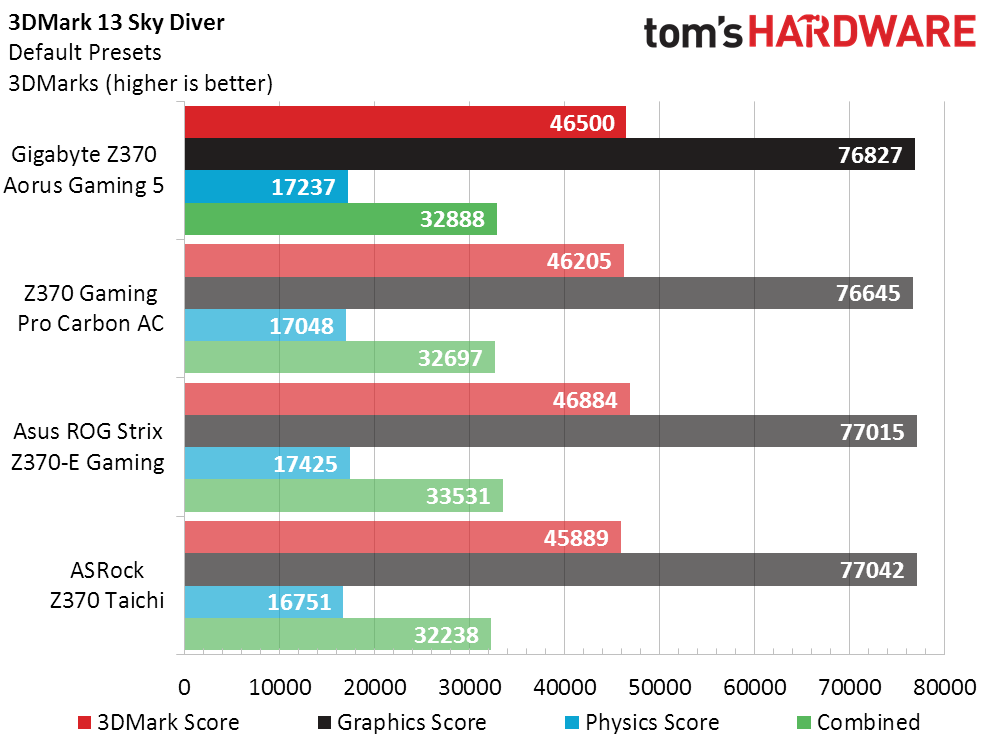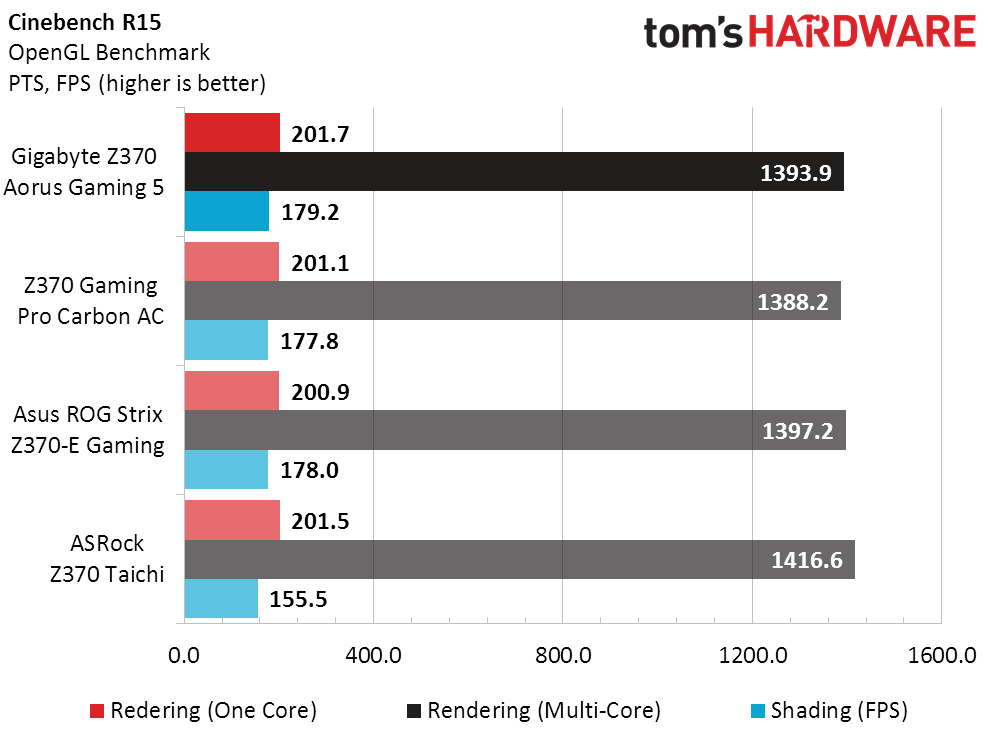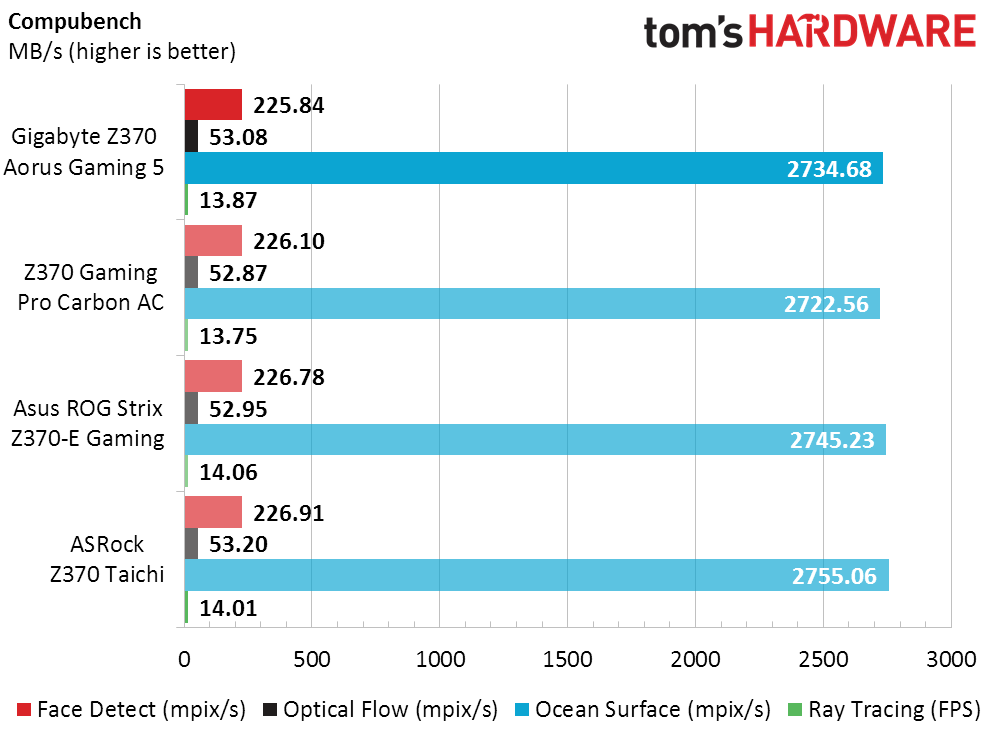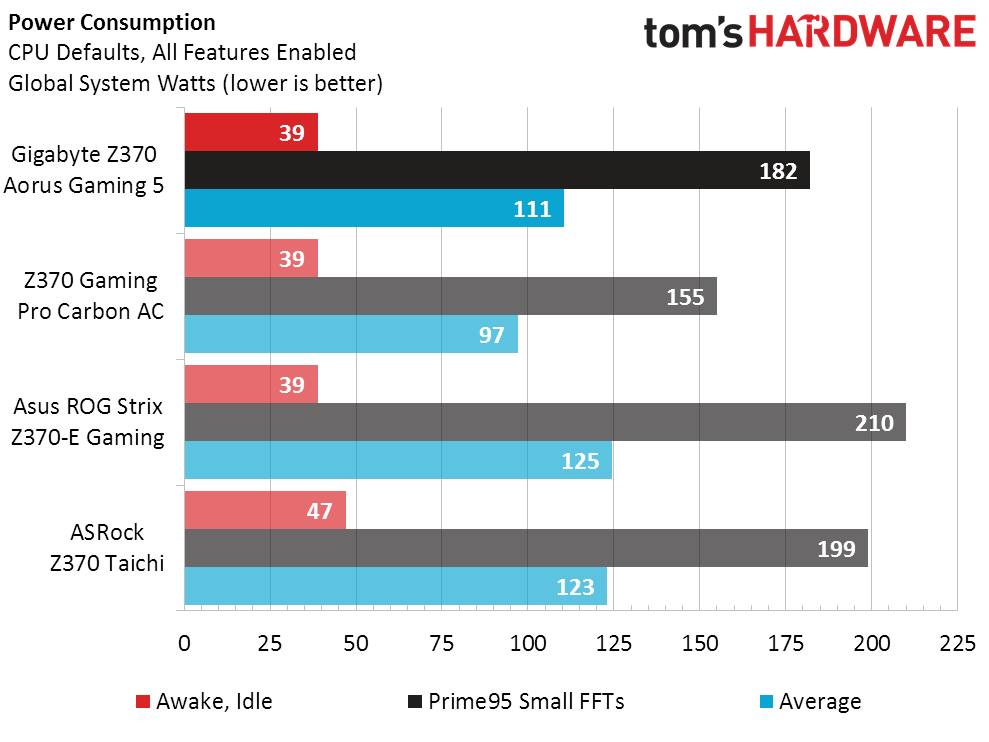Gigabyte Z370 Aorus Gaming 5 Review: Big Flash, Medium Cash
Why you can trust Tom's Hardware
Benchmark Results & Final Analysis
Synthetic Benchmarks
Synthetic benchmarks do a great job of showing how well individual components perform. Unfortunately, that means the more boring the charts are, the better the represented companies have done complying with things like Intel’s CPU specifications.










There was a slight bulge in the 3DMark Firestrike scores for the Z370 Gaming Pro Carbon AC and ROG Strix Z370-E Gaming, but both were consistent in other GPU-oriented tests such as Compubench. Moreover, those competing boards were also first and second in Sandra Bandwidth, where advanced memory timings are the only place companies can make noticeable optimizations without us turning up evidence of “cheating”.
3D Games
We’ve maintained a clean image of our original benchmark suite to prevent software-related performance changes, yet Ashes and F1 2015 performance has been on a gradual climb since its creation. Maybe updated chipset drivers are helping. Maybe it's firmware related? The Z370 Aorus Gaming 5 still finishes second overall behind the ROG Strix Z370-E Gaming, and that board was tested two months ago.




The Z370 Gaming Pro Carbon AC’s shortfall in Talos is due to the overhead of its Nahimic software, which is Talos compatible. Disabling the software disables a few handy (and paid-for) features, but proves that the FPS is still available to those willing to sacrifice this feature.
Timed Applications



Less time means more performance, but nothing significant stands out in our timed application tests. It looks like we’ll need to rank the boards in other ways, such as overclocking, features, and price.
Power, Heat, & Efficiency



MSI’s low full-load power use should be legendary by now, and one of the payoffs was reduced heat. It appears to do this by reducing core voltage to the lowest stable setting, which means the power savings percentage wouldn’t be applicable to overclocked systems. At least the Z370 Aorus Gaming 5 came in second-place here.
Overclocking
The Z370 Aorus Gaming 5 overclocks so eagerly that it left this reviewer with a conundrum: To limit the amount of time it takes to finish an evaluation, I first find the highest stable multiplier and then increase the BCLK using only 1 MHz steps. Using this method, the Z370 Aorus Gaming 5 reached the same 48x 101 MHz as the Z370 Gaming Pro Carbon AC. The CPU would crash on either board at the next test step, 48x 102 MHz, when validating with Prime95 small-FFTs.
Get Tom's Hardware's best news and in-depth reviews, straight to your inbox.
Yet the same time limits also caused me to choose a 20x minimum CPU ratio when evaluating BCLK overclocking, and the Z370 Aorus Gaming 5 reached a new high of 243 MHz. Multiplying that by 20, we get 4060 MHz. Less than the 4888 that would have been found at 48x 102 MHz, I picked the 48x 101 MHz result for the sake of chart consistency.
The Z370 Aorus Gaming 5 isn’t the first board to reach DDR4-4040, but it’s the only one in today’s comparison to do so. The result is an astronomically-high dual-channel data rate of 44GB/s.
Bottom Line
The Z370 Aorus Gaming 5 performed slightly better than the same-priced Z370 Gaming Pro Carbon AC in today’s evaluation, giving it a slight lead in performance-per-dollar. Gigabyte’s board comes with an extra M.2 slot, but that slot steals two lanes from the four-lane PCIe slot present on both models. It also adds a front-panel Gen2 USB connector, but feeds it only a Gen1 connection. And MSI offers a higher-bandwidth version of Intel’s recent-generation Key-E Wi-Fi controller, so there are advantages to both.
For a few dollars more, the ROG Strix Z370-E Gaming provides a front-panel Gen2 USB connector that’s fed by a second 10Gb/s controller, but enabling that controller disables two of its PCIe x1 slots. It also has one fewer M.2 storage interface, but it does include Realtek’s 866Mb/s Wi-Fi.
Another $15-or-so gets buyers the ASRock Z370 Taichi. We again scale back to Intel’s 433Mb/s Wi-Fi controller, but the Taichi adds a second Gigabit Ethernet port. Like the Asus board, it also has a second USB 3.1 Gen2 controller to feed a front-panel Gen2 cable.
Decisive value leadership is tough to find in this hyper-competitive market, but the Z370 Aorus Gaming 5 at least has one compelling feature to shift show-offs in its direction: More onboard RGB lighting. And for those who love the board but hate the lighting, it can be switched off by zone, or in its entirety.
MORE: Best Motherboards
MORE: How To Choose A Motherboard
MORE: All Motherboard Content
-
sp5618 First-time PC builder does this board have a thunderbolt 3rd generation 40 MB? If not what motherboards in the ATX form factor Have it? Thank youReply -
Crashman Reply
Leave it empty?20951510 said:I don't know what to do with the third M2 slot
Chipset limitations are butting up against the desire to extend M.2 support: These companies want a third x16 slot with four lanes, and at least two NVMe M.2 slots, but that combination uses 12 of the 30 HSIO ports. Gigabyte added another NVMe M.2 slot that kills off a couple SATA lanes when its being used, I guess they could have just left off that M.2 slot, knocked the SATA port count down to four, and included a fully-utilized Thunderbolt controller instead.20951647 said:First-time PC builder does this board have a thunderbolt 3rd generation 40 MB? If not what motherboards in the ATX form factor Have it? Thank you
Nearly all of these boards are designed to host a Thunderbolt add-in card in the four-lane slot, but most of those slots require you to sacrifice some other interface. Look for the Thunderbolt add-in-card header.
On the other hand, Mini ITX has fewer slots, and several of those boards have Thunderbolt controllers to use up some of the leftover HSIO.
-
Crashman Reply
I realize that Gigabyte is using split-phase design. I've always hated counting phases because the number hasn't meant anything since companies came out with 24 low-amperage phases to compete with the six to twelve high-current phases of competitors back in the Core 2 days. I only include the easiest number because so many people don't understand what i just said.20951814 said:1 inductor does not equal 1 phase
-
android_dev It's a 8+3 phase with the voltage controller being a true 4 phase on the CPU section doubled to 8 with additional mosfet drivers while the other 3 are for iGPU.Reply -
Crashman Reply
I thought the other three were for the entire system agent, including the memory controller :)20976842 said:It's a 8+3 phase with the voltage controller being a true 4 phase on the CPU section doubled to 8 with additional mosfet drivers while the other 3 are for iGPU. -
android_dev Reply20976876 said:
I thought the other three were for the entire system agent, including the memory controller :)20976842 said:It's a 8+3 phase with the voltage controller being a true 4 phase on the CPU section doubled to 8 with additional mosfet drivers while the other 3 are for iGPU.
It's another voltage controller that controls the memory VRM which is a Richtek RT8120. The CPU Core Voltage VRM uses an Intersil 95866 which is a true 4+3 phase which Gigabyte has doubled to 8+3 phase. System Agent and VCCIO use Richtek RT8120D which is 1 phase each.
-
Crashman Reply
I didn't mention the memory signal voltage controller, for which the components can usually be seen separated from the group of things for various CPU devices ;)20976914 said:20976876 said:
I thought the other three were for the entire system agent, including the memory controller :)20976842 said:It's a 8+3 phase with the voltage controller being a true 4 phase on the CPU section doubled to 8 with additional mosfet drivers while the other 3 are for iGPU.
It's another voltage controller that controls the memory VRM which is a Richtek RT8120. The CPU Core Voltage VRM uses an Intersil 95866 which is a true 4+3 phase which Gigabyte has doubled to 8+3 phase. System Agent and VCCIO use Richtek RT8120D which is 1 phase each.
As for the 4/8, I say split, you say doubled. But getting back to the original message, we were seeing 24+ voltage regulators on P35/P45 boards before someone else (I think MSI) came out with higher capacity parts on a 6-phase design that could do the same work at lower cost. Soon after we were frying 12 phase regulator components and not frying 8 phase components when doing the same thing, because the boards with the 12 phase regulators were using substandard parts. Then some companies put high-amp chokes on low-amp MOSFETs and I blew more boards.Then some companies put high-amp chokes AND MOSFETs on the same board and extreme overclockers blew traces surrounding the MOSFETs. Then some companies used a thicker copper layer on the PCB with higher amp parts and hollow EPS12V pins and I blew out the connector. We even had sockets without enough contact pressure on the pins blowing out. Because of this, the only way I can find the weak point is through testing. And because of that, I'm now treating "phase count" as a matter of trivia.
-
android_dev Reply20977076 said:
I didn't mention the memory signal voltage controller, for which the components can usually be seen separated from the group of things for various CPU devices ;)20976914 said:20976876 said:
I thought the other three were for the entire system agent, including the memory controller :)20976842 said:It's a 8+3 phase with the voltage controller being a true 4 phase on the CPU section doubled to 8 with additional mosfet drivers while the other 3 are for iGPU.
It's another voltage controller that controls the memory VRM which is a Richtek RT8120. The CPU Core Voltage VRM uses an Intersil 95866 which is a true 4+3 phase which Gigabyte has doubled to 8+3 phase. System Agent and VCCIO use Richtek RT8120D which is 1 phase each.
As for the 4/8, I say split, you say doubled. But getting back to the original message, we were seeing 24+ voltage regulators on P35/P45 boards before someone else (I think MSI) came out with higher capacity parts on a 6-phase design that could do the same work at lower cost. Soon after we were frying 12 phase regulator components and not frying 8 phase components when doing the same thing, because the boards with the 12 phase regulators were using substandard parts. Then some companies put high-amp chokes on low-amp MOSFETs and I blew more boards.Then some companies put high-amp chokes AND MOSFETs on the same board and extreme overclockers blew traces surrounding the MOSFETs. Then some companies used a thicker copper layer on the PCB with higher amp parts and hollow EPS12V pins and I blew out the connector. We even had sockets without enough contact pressure on the pins blowing out. Because of this, the only way I can find the weak point is through testing. And because of that, I'm now treating "phase count" as a matter of trivia.
Hmm.. interesting, I was too young back then when you reviewed that stuff 10+ years ago now but yeah I read circuit analysis reviews of this motherboard and that's how I got the info for what I wrote above.



